One of my highlights of Cordoba was finding this 14th century Synagogue. It’s one of only three synagogues from this era left standing – the other two are in Toledo. If you are spending time in Cordoba then don’t miss this…it’s easy to get to (walkable from the Mezquita) and you don’t need a guide.
Getting to the Cordoba Synagogue
You can walk to the Synagogue from the Mezquita (The Mosque-Cathedral of Cordoba) in about 5 minutes – walk into La Juderia (the Cordoba Jewish quarter) and walk past the Maimonides statue (pictured below) and down the side of the bull fighting museum.
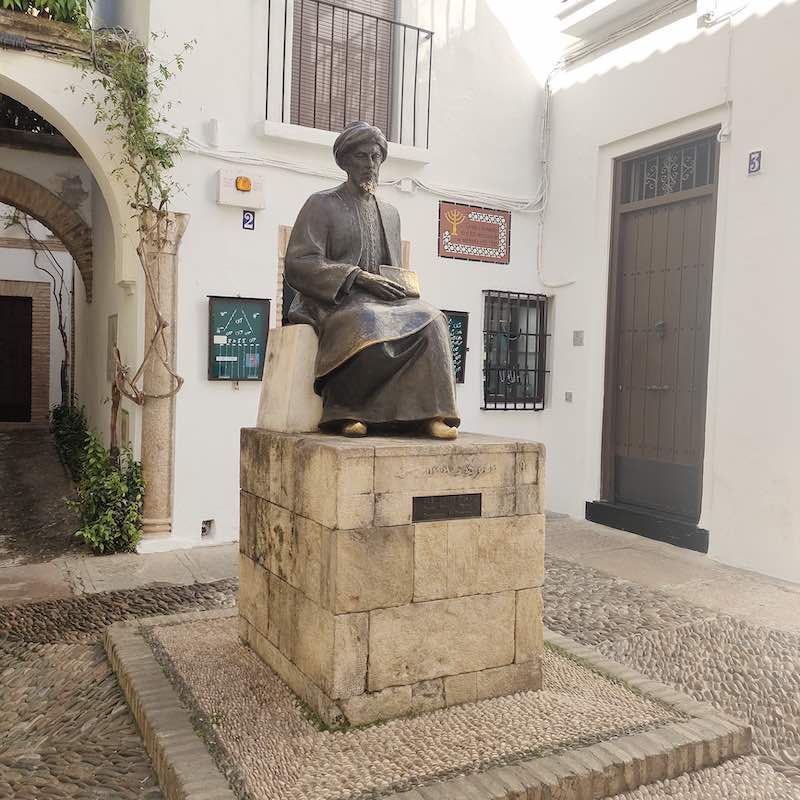
The Synagogue is free to get in and you don’t need to book tickets in advance. Not as many people know about it so it’s nowhere near as packed as the Mezquita. It’s quite tucked away on a narrow street called Los Judíos (The Jews) and is not really recognisable from the outside, but it is signposted.
You only really need 15 minutes there to have a look and read the signage, but believe me it is worth it for sure. If you are already at the Mezquita in Cordoba you would be silly not to make the short walk for this.
Cordoba Synagogue opening hours
It is usually open from 9am to 9pm, but times may vary on Sundays and holidays (it sometimes closes at 3pm). Double check with locals regarding holidays such as Christmas and Easter – although these are Christian rather than Jewish holidays, the Synagogue is not practicing but a historical monument so the opening times are affected by the usual Spanish holidays.
Although it is not an active Synagogue with a current Jewish congregation, dress conservatively and keep quiet inside out of respect. Some of the people who run it have Jewish ancestry. It would be impolite to rock up in a vest top, shouting your head off, or snogging your lover in the corner!
The Synagogue is closed on Mondays (as are many attractions, so Monday is not the best day for a day trip to Cordoba).
History of the Cordoba Synagogue
The Synagogue of Cordoba was built in 1305 and is the only preserved Synagogue in andalucia after the expulsion of Jews in 1492.
Following the expulsion of the Jews in 1492 the Synagogue was used as the St. Quiteria hermitage. The house was also once used as a hospital and then an infant school. In 1588 it became the property of the shoemakers Corporation brotherhood under the new patronage of Saint Crispin and Saint Crispiniano. In the 19th century its panelling was replaced with a barrel vault and plasterwork, since its old roof was falling to pieces. Don Mariano Parraga, a priest, discovered the plasterwork on its walls in 1884, when part of the mortar walls of the synagogue fell down. One year later, in 1885, it was declared a national monument and restoration work on the synagogue began.
The small size of the Synagogue suggests that it may have originally been the private Synagogue of a wealthy man, but this has not been confirmed.
Visiting the Synagogue
The synagogue consists of three main areas – the courtyard, an external section with an upper gallery which was the women’s gallery and the main synagogue and men’s gallery. The courtyard is a unique trapezoid shape and it is believed that there were Mikveh (ritual baths for religious cleansing) and a Talmudic school (study of the Talmud – Jewish texts) existed in and around this area. And so the Synagogue complex may be larger than what now remains.
Cost to enter Cordoba Synagogue: Free although sometimes they charge a small amount 0,50€ for non EU residents.
Inside Cordoba Synagogue
Inside the Synagogue you will find stucco decoration in geometric pattern, moorish architecture and Hebrew inscriptions. Many of the inscriptions have been translated from Hebrew (the language of the Jewish people and their religious texts) and there is information on the Synagogue walls detailing what they say.
South Wall and Women’s Gallery
The women’s gallery is positioned above the first section in an upper gallery, which was typical of Synagogues at this time. The Southern Wall is where you will see the gallery and this is the side that leads out through the courtyard.
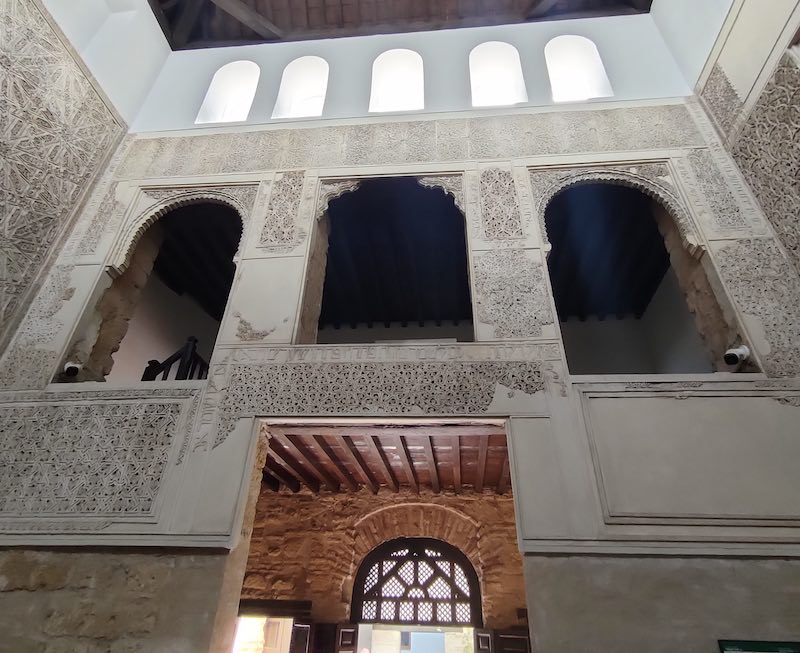
The inscriptions on the south wall read as follows:
In a vertical line on the right end of the south wall from bottom upwards and terminating in a rosette you will find some 84, 2-3…
“How amiable are the tabernacles, oh Lord of hosts!
My soul longeth, even feinteth for the courts of the Lord:
My heart and my flesh crieth out for the living God.”
In a vertical line on the left end of the wall from top downwards also commencing in a row that you will find psalm 13, 5-6…
“But I have trusted thy mercy;
My heart shall rejoice in thy salvation,
I will sing unto the Lord;
Because he has dealt bountifully with me. Amen and Amen.”
The inscription is that frame the balconies are in a very poor state today and unfortunately we can hardly trace a few words. However it is believed to be the words of psalm 122. In a horizontal line commencing on a line with the beginning of the arch over the right-hand balcony and reading from right to left we reach the horizontal line over the central balcony with what is believed to be the following words:
“Pray for the peace of Jerusalem they shall prosper that love thee. Peace be within thy walls, and prosperity within thy palaces. For my brethren and companions’ sakes, I will now say, peace be within thee. Because of the house of the Lord our God I will seek thy good.”
The inscription continues down the left side of the central balcony as far as the end of the wall towards the left going round the balconies (Psalm 102, 12-13 and Psalm 57, 2-3):
“But thou, Oh Lord shalt endure forever, and thy remembrance unto all generations.
Thou shalt arise and have mercy upon Zion: for the time is come to favour her, yea the set time is come.
Be merciful unto me, Oh G_d be merciful unto me for my sole trusted in thee: Yea, in the shadow of thy wings will I make my refuge. Until these calamities be overcast. I will cry unto G_d most high, unto G_d that performeth all things for me.”
The inscription that finds the entrance door right side bottom upwards terminating in rows it is proverbs 8, 34 and Isaiah 26, 2….
“blessed is the man that heareth me, watching.”
Top part, right to left and terminating in a row it reads…
“Daily at my Gates, waiting at the posts of my doors. Open ye the gates, that the righteous nation might enter in.”
and finally, from the left side top downwards reads:
“which keepeth the truth.”
West Wall (with Multifoil Arch)
The West wall has a multi foil arch (an arch with smaller arcs going around the main big arch). This is sometimes called a cusped arch, polylobed arch, or scalloped arch and makes the Cordoba Synagogue instantly recognisable as Moorish architecture.
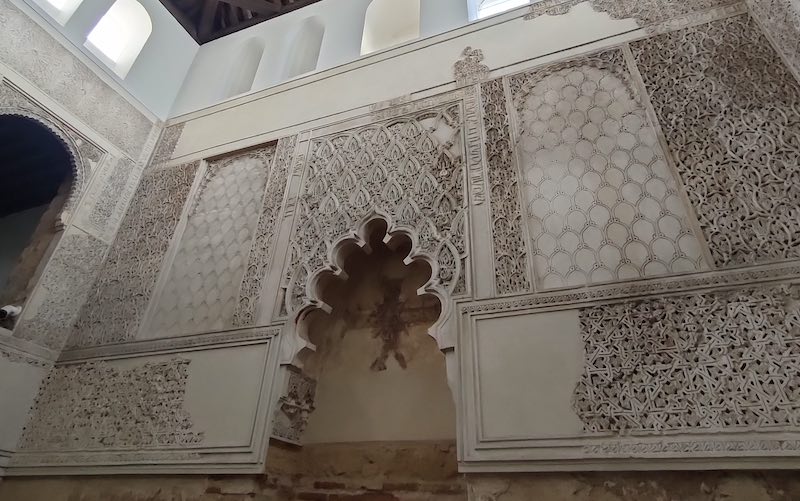
On this wall, there is an inscription on the frame of the arch which seems to refer to the Song of Songs (4, 4)…
“I am built like tower of the Messiah, Lord.”
Sadly some of the other inscriptions on this wall are not well preserved enough to translate. It is thought that the bottom line of the west wall from right to left read psalm 22, 28…
“All the ends of the earth shall remember and turn unto the Lord: And all the kindred of the nations shall worship before thee. For the kingdom is the Lord’s and he is the governor among the nations.”
North Wall (five small windows and three arches)
The Northern Wall is the one with the five small windows and three arches, opposite the women’s gallery. This wall contains some well preserved text, some which continues onto the West Wall.
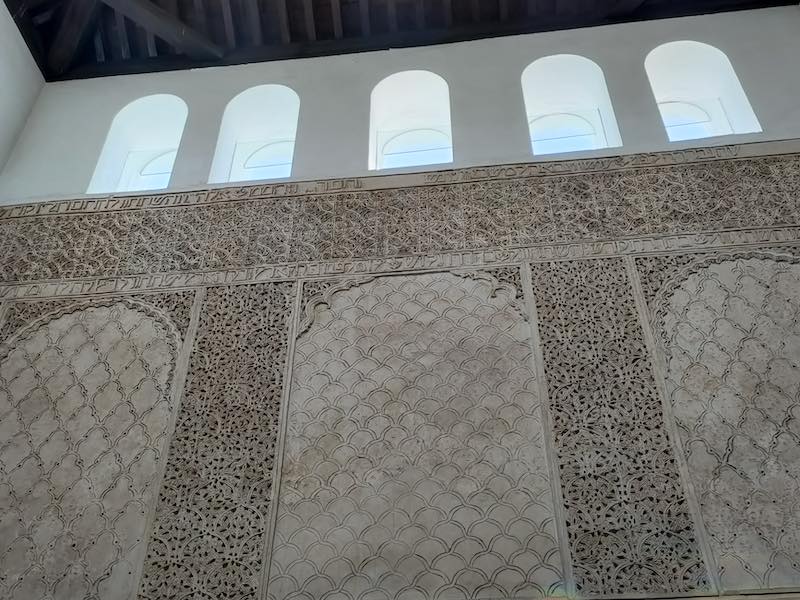
The top line on the north Wall from right to left contains psalms 95,6; 132,7 and 99,5…
“O come, let us worship and bow down: let us kneel before the Lord, our maker. We will go into his tabernacles: We will worship at his footstool.
Exalt ye the lord our G_d and worship at his footstool, for he is holy.”
The top line of the West and South walls was from right to left contain Psalm 100,1b .2a; 86,9; 95,1…
“Serve the lord with gladness: Come before his presence with singing
All nations home now cast made shall come to worship before thee, oh lord and shall glorify thy name.
Oh come let us sing unto the Lord: let us make a joyful noise to the rock of our salvation.”
The bottom line on the north Wall from right to left read Psalm 29,2; 96,9 and 66,4…
“Give unto the Lord the glory due unto his name;
Worship the Lord in the beauty of holiness. Fear before him all the earth.
All the earth shall worship thee and shall sing unto thee, they shall sing to thy name, Selah.”
Eastern Wall (with Menorah in the alcove)
In the alcove of this Wall you will find a Menorah (Jewish 7 branched candlestick). The well preserved inscription on the Northern wall refers to he founder of the synagogue, Yishaq Moheb and to the date of the construction. It reads written from right to left.
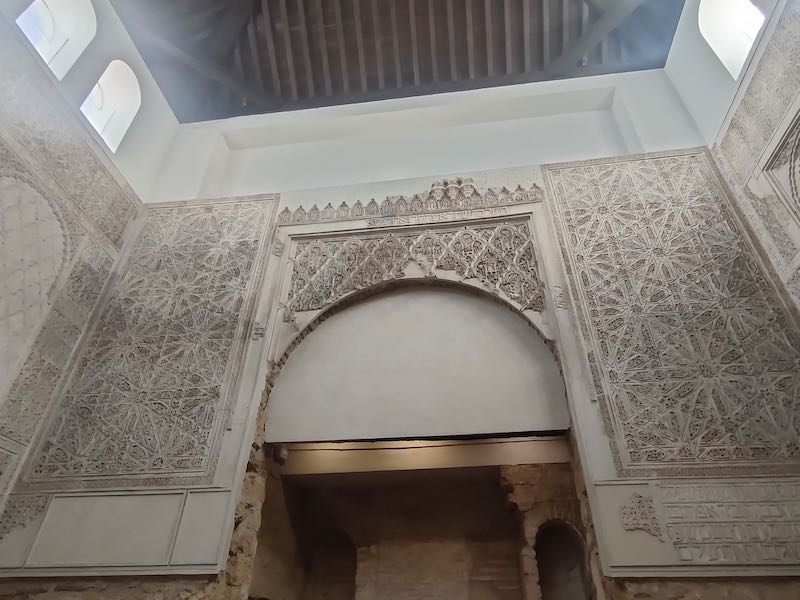
“Provisional sanctuary and abode for the testimony completed by Yishak Moheb, son of Mr Efraim Wadawa in the year 75. So return, oh God Haisten to return to Jerusalem!”
(Insert photo of Inscription)
On the left of the chamber set in this wall must have been another inscription which has been totally lost. The arch that surrounds this chamber reads like this:
Right side from bottom upwards, across and then down (Psalm 138,2)
“I will worship toward the holy temple, and praise thy name. For loving kindness and for the truth for the hast magnified with a word above their name one thing have I desired of the Lord that will I seek after; that my dwell in the house of the Lord all the days of my life, to behold the beauty of the Lord, and to enquire in his temple.”
Cordoba Synagogue – Overall Verdict
This really is a stunning example of Moorish architecture and Jewish heritage in Spain. As it’s so close to the Mezquita, it is a free site that really shouldn’t be missed.
Further Reding on Cordoba and Andalucia
If you enjoyed this article on Cordoba Synagogue and are interested in Moorish architecture then you should also definitely read this article on visiting Madinat Al Zahra.
You might also find this article helpful on how to spend one day in Cordoba.
